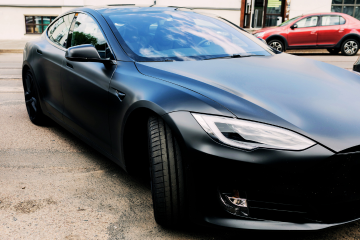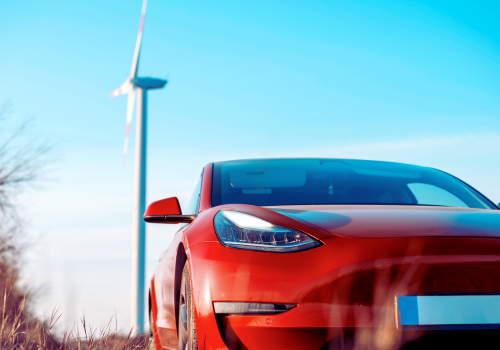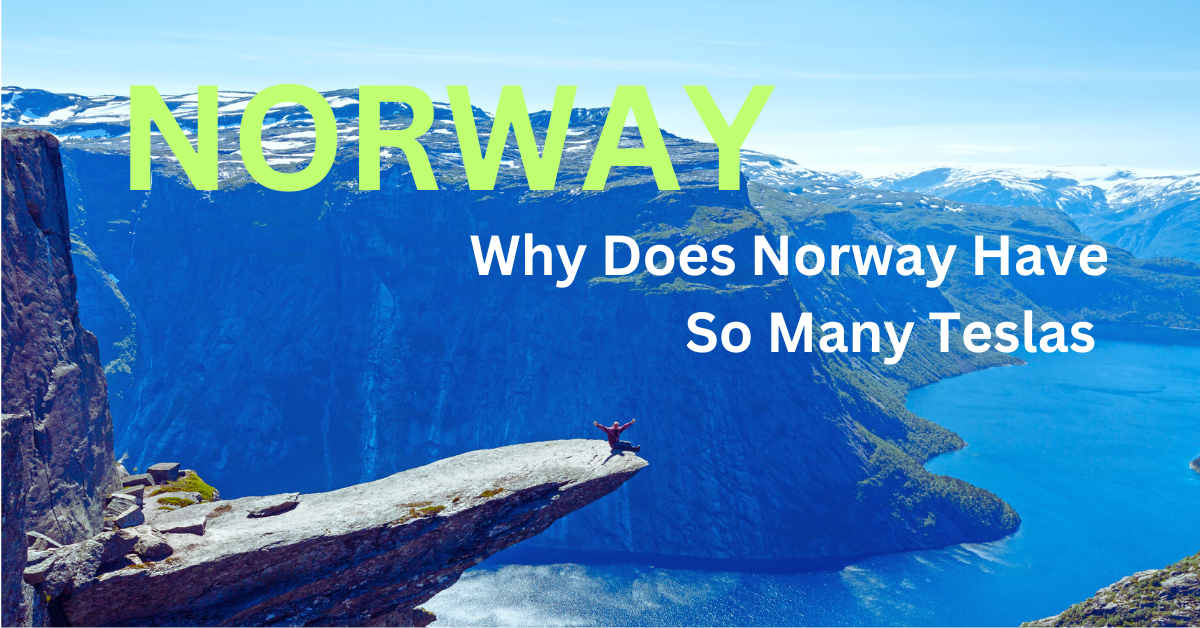Why Does Norway Have So Many Teslas?
Tesla’s Runaway Success in Norway
Norway has emerged as a global leader in electric vehicle (EV) adoption, with over 50% of new car sales now electric. And of all the EV brands sold in Norway, Tesla dominates the market. Last year 2023, a remarkable 82% of new car sales have been electric, demonstrating the country’s rapid transition away from internal combustion engine vehicles.
Tesla’s sales success in Norway has also proven unimpacted by high-profile conflicts between CEO Elon Musk and Nordic trade unions over working conditions. Despite protests and calls for consumer boycotts, Norwegian buyers are still eagerly snatching up the latest Tesla models as fast as they can be delivered.
The California-based automaker’s most popular model in Norway is currently the Tesla Model Y midsize crossover SUV, which topped sales charts for 2022 thanks to its blend of practicality, performance, range, and access to Norway’s generous electric vehicle perks. Tesla’s pioneering Model 3 sedan, Model X SUV, and Model S sedan also rank among Norway’s top selling vehicles as consumer appetite for luxury EVs continues growing.
But why has Norway emerged as such uniquely fertile ground for Tesla to dominate compared to other European countries? A confluence of policy incentives, infrastructural investments, environmental values, and wealthy early tech adopters have combined to give Tesla an unassailable lead over other electric and fossil fuel car brands. Let’s analyze the major factors propelling this EV boom with Tesla seated firmly in the driver’s seat.
Government Incentives Reduce Costs
One of the biggest reasons behind Norway’s Tesla adoption boom comes down to cold hard cash. The Norwegian government has implemented an extensive array of financial incentives, tax reductions, and cost savings programs specifically aimed at making electric vehicles extremely affordable to own and operate.
For example, while most new car purchases in Norway are subject to hefty 25% VAT (value added tax) and other sales taxes that can nearly double the price paid over base MSRP prices, electric vehicles like Teslas enjoy a complete exemption. This tax relief equates to instant savings of $10,000 USD or more for Norwegian EV buyers.
Additionally, owning a Tesla in Norway comes with savings on toll roads, parking, charging costs, and annual road taxes. All costs that quickly add up during daily commuting and travel. Norwegian Tesla owners have calculated total lifetime savings of more than $50,000 USD after accounting for all monetary incentives.
For a wealthy nation already prone to high taxes on traditional autos, the financial carrots offered by Norway have persuasively switched buyers towards premium electric offerings like Teslas. Let’s explore some of the other complimentary factors that turned Norway into such receptive soil for luxury EVs like Tesla to take root in.
| Category | Reasons for High Tesla Adoption |
|---|---|
| Financial Incentives | – No sales tax or VAT on EVs, Exemption from import duties, No toll roads or parking fees, Lower annual road taxes |
| Infrastructure | – Abundant renewable electricity (98% hydroelectric), Over 10,000 public EV charging stations, Small geography reduces range anxiety |
| Cultural Factors | – Progressive values embracing sustainability, Desire for energy independence, Enthusiasm for high-tech solutions |
| Market Conditions | – Wealthy nation making incentives attractive, Tesla seen as aspirational luxury status symbol, Advanced driver assist technology valued |
Norway Offers Ideal Conditions for EVs

Beyond the financial incentives, Norway as a country possesses inherent geographic and demographic qualities that make it exceptionally well suited for electric vehicle adoption.
For starters, Norway’s small size and compact population distribution means most travel stays within close radius. This alleviates challenges with range anxiety that EVs with lower battery capacities might otherwise encounter on longer trips.
Furthermore, thanks to Norway’s vast investments into renewable hydroelectric, wind, and solar power, charging an EV can be done without generating significant carbon emissions. In fact, experts calculate driving an electric vehicle in Norway uses 98% renewable electricity. This results in a far lower lifetime carbon footprint than equivalent miles traveled using internal combustion engines.
Socially, Norway has developed into a progressive culture embracing high-tech solutions and sustainability values. Enthusiasm for innovation and desire to showcase independence from revenue sources like oil align neatly with the gratification from leading EV adoption trends. For affluent Norwegians, going electric also enables conspicuously eco-conscious consumption signaling status and taste preferences beyond just transportation needs.
With ideal ingredients in place both economically and culturally, Norway rapidly emerged as a highly receptive market for premium EV brands. And no brand has positioned itself as expertly to capitalize on these trends at the luxury end than California’s audacious upstart – Tesla.
The Popularity of Tesla Vehicles

As a pioneer of exclusive, high-performance electric vehicles loaded with tech innovations like advanced autopilot driving assistance, Tesla vehicles hold tremendous cachet and curb appeal with status-conscious Norwegian buyers.
Driving a Tesla in Norway has become a definitive signal of affluence, forward thinking taste, and refinement. Their sleek, modern designs and tablet-like interfaces project cutting-edge sophistication. Acceleration and handling amplify driver engagement thanks to instant torque delivery from electric motors. Tesla’s advanced driver assist systems in the Autopilot and FSD (full self-driving) suites also uniquely suit Norway’s narrow, winding roads and variable weather conditions.
And as battery capacities continue improving to deliver real-world ranges meeting or exceeding internal combustion counterparts, concerns about electric vehicle limitations have evaporated – especially amongst wealthier demographics who view Teslas as exclusive objects of desire rather than appliances.
The potent blend of technical prowess and conscious luxury built into the Tesla brand image has dovetailed immaculately with Norway’s appetite for displaying progressiveness. As more Teslas populate Norway’s streets, positive sightings and word-of-mouth endorsements spread rapidly thanks to close social connections – spurring further adoption in viral fashion.
With Tesla firmly entrenched as Norway’s preferred electric luxury vehicle, has the country’s passion for premium EVs peaked or only just begun? Some intriguing open questions remain about incentive programs potentially shifting over time as EVs gain broader mass-market appeal.
Can Incentives Be Sustained?
While Norway’s electric vehicle incentives have proven immensely effective at spurring adoption across demographic segments so far, changes may still evolve down the road.
Some economic policy analysts argue incentives should start phasing out as electric vehicles reach sticker price parity and become cost competitive with fossil fuel equivalents, even without subsidies. Additionally, questions persist around the ethics of granting generous incentives to buyers who can readily afford $100k+ luxury vehicles like high-end Tesla Models S and X.
As Norway continues marching towards a future where electric vehicles dominate sales, there are calls to refocus incentives more on affordable mass market EVs rather than lavishing wealthy elite owners with tax breaks on vehicles like decked-out Tesla Model X’s. The counterargument points to the halo effect where getting luxurious, aspirational EVs like Teslas on the roads builds public acceptance and familiarity with electric transport overall.
Tesla’s first mover advantage in capturing affluent Norwegian buyers who value performance, styling, and innovation means they are well positioned to retain market share even as subsidies potentially decline. But competitors are responding with fresh EV offerings sporting the latest features and Norway’s ever-growing charging infrastructure will support more models.
So while Tesla enjoys surging popularity today as Norway’s preferred EV brand, the coming years will determine who ultimately wins out as ownership expands beyond early adopters. One thing is certain – Norway’s example has demonstrated the remarkable pace of EV transformation achievable when supportive policies align with public sentiment and national values around sustainability.
Tax Breaks Cut Purchase Costs Significantly
To understand why Norway has become such an electric vehicle friendly environment especially advantageous for premium brands like Tesla, it helps examining exact savings from incentives.
Importing and registering most fossil fuel vehicles in Norway is subject to heavy taxes including 25% value added tax (VAT) and additional registration fees. This easily doubles the base cost of an ICE car or SUV. By contrast, pure electric vehicles are completely exempt from VAT, taxes, and import duties – instantly slicing away $10,000+ from the purchase price.
For example, the base price of a new Tesla Model Y Long Range in Norway converts to around 500,000 NOK. But after subtracting tax savings from the VAT exemption along with other registration perks, the effective pre-incentive price drops over 120,000 NOK down to 377,000 NOK (approximately $38,500 USD). And that’s before additional EV ownership incentives over time.
Similar math applies across Tesla’s Norway lineup, creating huge discount gaps compared to petrol rivals. These major upfront savings motivate buyers to willingly absorb Tesla’s brand premium for the performance, styling, and status offered. Let’s examine the additional savings that make EV ownership in Norway so affordable.
EV Ownership Perks Add Up
Beyond the major purchase price savings at time of sale, Norwegian EV owners continue enjoying benefits that minimize the total cost over the vehicle lifetime – further incentivizing Tesla purchases.
For starters, Norway has invested heavily in a nationwide electric vehicle charging network with over 10,000 public charging points distributed across the small geography. Not only does this alleviate range anxiety, but all public charging is currently free for EV drivers. Even fast chargers capable of quickly replenishing 200+ miles of charge per hour cost nothing to use. So fuel costs get eliminated from the ownership equation.
Additionally, electric vehicles are exempt from toll roads and receive free municipal parking in cities like Oslo and Bergen. These perks encourage daily EV use by saving money previously allocated towards fees, charges, and repairs associated with internal combustion vehicle operation.
When totaled together, experts project the lifetime ownership costs of a Tesla Model 3 in Norway, for example, can save over $50,000 compared to a petrol-powered BMW 3-Series when factoring purchase price breaks plus operating savings over a typical ownership duration.
The sheer magnitude of financial incentives provided to EVs in Norway make switching to electric transport – especially at the premium end of the market where Tesla dominates – a rational financial choice motivated by more than ideology for Norwegian car buyers.
Norway’s Investments in Renewable Energy
Aiding adoption of electric vehicles in Norway involves ensuring they run on clean energy sources without heavy reliance on fossil fuels. Fortunately, proactive investments in renewable electricity generation over prior decades enable Norway’s EV fleet to charge up with minimal carbon impact.
Experts assess 98% of the electricity consumed in Norway originates from renewable hydroelectric plants. Abundant rivers across Norway’s rugged terrain allow capture of plentiful greenhouse gas-free hydro power. Supplementing this foundation, new wind farms and solar plants coming online also boost eco-friendly capacity.
This extensive carbon-free energy infrastructure means that electric vehicles charged in Norway benefit from an exceptionally low lifetime carbon footprint. For example, a typical EV charged on Norway’s grid would emit under 20,000 lbs. CO2 over 150,000 miles of driving. A petrol car would emit over 4 times higher emissions – amplifying EVs’ environmental credibility.
So Norwegian policymakers have skillfully aligned electric vehicle adoption incentives with domestic energy investments to enable genuine sustainability improvements, not just outsourced emissions.
The result is an energy independent path towards greener transportation free from overseas hydrocarbon imports. Tesla and other EV manufacturers eagerly highlight these perks to reinforce competitive positioning in the Norwegian marketplace, powering sales momentum.
The final section will cover cultural reasons explaining Norway’s receptiveness towards EVs and conclude by recapping Tesla’s dominant position resulting from align
Why Norwegians Have Embraced EVs ?
Beyond the financial incentives and infrastructure powering Norway’s electric vehicle boom, important cultural attitudes and values have also fueled high adoption rates.
Norway has steadily cultivated a national identity embracing eco-conscious policies, innovation, and self-sufficiency. People take pride in responsible stewardship allowing both energy independence thanks to renewables while preserving Norway’s iconic natural landscapes.
Relatedly, Norway’s luxury taxes intentionally price the externalities of fossil fuel pollution at high rates. This motivates consumers towards cleaner options by adding huge premiums for petrol vehicles not shouldered by EVs. Aligning with sustainability values, EVs exempt owners from these penalties.
The Norwegian culture also enthusiastically adopts advancements in technology, design, and performance which the Tesla brand amply delivers through marvels like instant acceleration via precision torque vectoring. And EVs require far less maintenance while providing years of reliable service in Norway’s harsh climate – attributes that pragmatic Norwegian temperaments appreciate in vehicles.
Conclusion: The Power of Aligned Incentives
Thanks to aligned incentives spanning infrastructure build-outs, purchase policies, renewable electricity supplies, and cultural attitudes, Norway has systematically optimized itself as an extremely hospitable environment nurturing electric vehicle adoption. Tesla in particular has thrived under these ideal conditions – leveraging world-class EV technology catering to luxury buyers ready to switch from old world combustion customs.
As Norway’s electric transition continues maturing, time will tell whether incentives shift down market and competitors catch up. But for now, Tesla finds itself cruising in the fast lane as both a driver and beneficiary of Norway’s EV-friendly mindset permeating consumers, policymakers, power companies and everyday citizens alike. The stunning result provides proof positive of the pace of transformation possible when an entire country buys into battery powered mobility.
